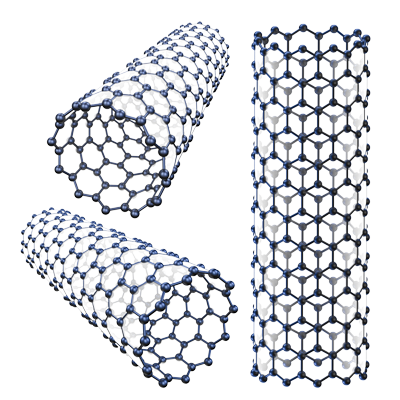_Part of the process (discharging) for electric nanotubes
Carbon nanotubes are able to conduct electricity through frictionless ballistic electron transport across their surface - a hundred times more current than copper wire.
Researcher and author: Dr. ( Afshin Rashid)
Note: Since carbon nanotubes are able to pass the electric current through the ballistic transfer of electrons without friction - this current is a hundred times higher than the current that passes through the copper wire - so nanotubes are an ideal choice for many They are one of the applications of microelectronics.
According to their geometric shape, nanotubes become conductive or semi-conductive, depending on how the graphite plates that make them are rolled. In other words, because the nanotubes look like an interwoven wire at the molecular level. The carbon atoms are connected to each other in a hexagonal pattern, and these hexagonal patterns form cylindrical walls, the size of which is only How many nanometers is it? The twist angle of a type of nanotube, which is defined as the angle between the axis of its hexagonal pattern and the axis of the tube, determines whether it is conductive or non-conductive. that changing the radius also provides the possibility to close the length of the band and to insulate the metal nanotube. So it can be said that the two basic parameters that play an important role in this, one is the structure of the nanotube and the other is its diameter and size. From a conductor to a semiconductor or an insulator, the electrical level of the nanotubes can be changed depending on whether the molecule Ballistic transfer of electrons without friction from the surface of carbon nanotubes is suitable on the nanotube surface .
Multi-walled carbon nanotubes (CNTS) are made of many movable single-walled tubes. Because of their extra layers, multi-walled pipes are stronger than single-walled types. CNTs are the preferred types of nanotubes for use in nanoelectronic devices. In nanotubes, every three carbon atoms have the ability to store one lithium ion, while in graphite, all six carbon atoms have the ability to store one lithium ion. Also, the ability to store energy in nanotubes is several times the volume of graphite electrodes.
When the liquid passes through coils of single-walled and multi-walled carbon nanotubes, an electric voltage is created. This technique is used to make liquid flow sensors to detect very small amounts of liquids and also to generate voltage in nano-micro electronic applications . It has also been shown that liquids with high ionic strength produce more voltage .
Conclusion :
The frictionless ballistic transfer of electrons from the surface of carbon nanotubes is proportional to the third root of the mass of atoms and molecules by increasing the amount of thermal power and resistance of nanotubes. Also, heating increases the strength of nanotubes and increases its tensile strength by six times, and the conduction of ballistic transfer of electrons without friction from the surface of carbon nanotubes also increases.
Researcher and author: Dr. ( Afshin Rashid)
Specialized doctorate in nano-microelectronics






